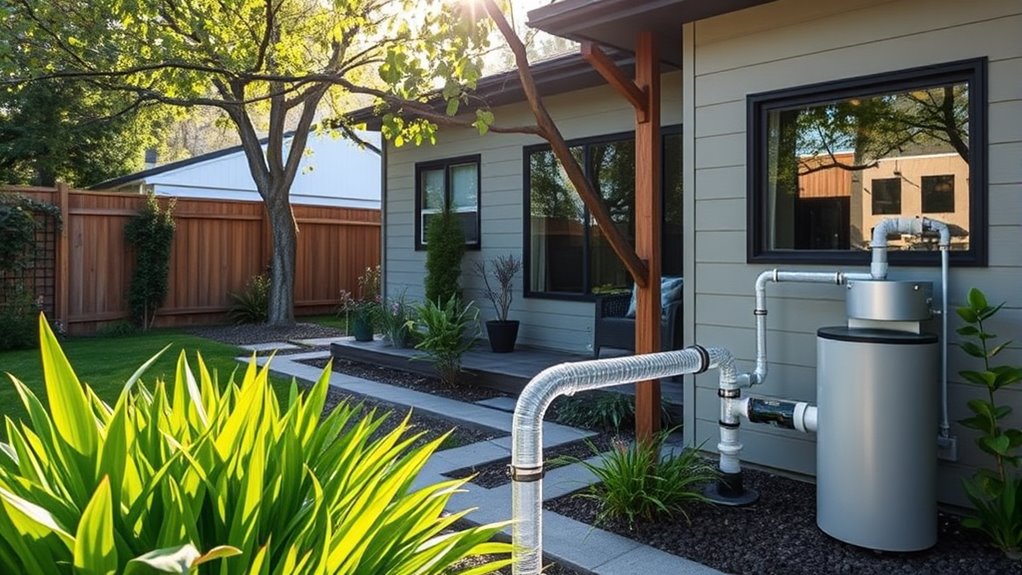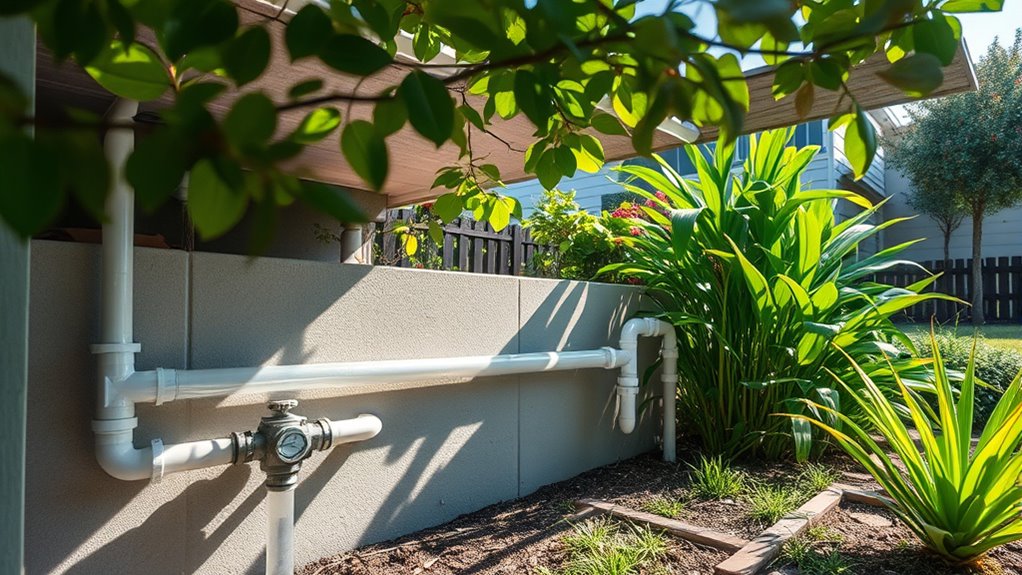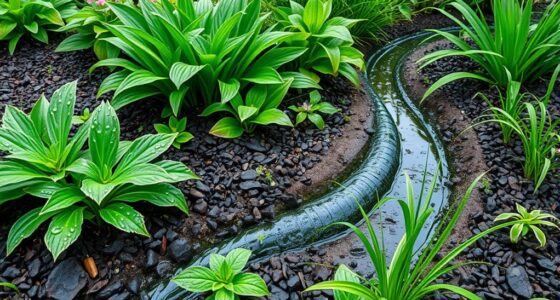Greywater systems for homes allow you to reuse wastewater from sources like sinks, showers, and laundry to conserve water and cut down on utility bills. By installing simple diverter valves, you can redirect greywater for outdoor irrigation or indoor use, helping you reduce dependence on municipal water. These eco-friendly setups are often DIY-friendly and promote sustainable living. Want to find out how easy it is to implement one in your home? Keep exploring to discover more.
Key Takeaways
- Greywater systems recycle wastewater from sinks, showers, and laundry for non-potable outdoor or indoor use.
- They reduce household water consumption and utility bills through efficient reuse.
- Installation involves installing diverter valves to redirect greywater from plumbing fixtures.
- Eco-friendly components ensure durability, corrosion resistance, and system longevity.
- Proper planning and adherence to local regulations maximize safety and environmental benefits.

Have you ever considered how much water you use daily that could be reused instead of squandered? Many household activities generate greywater—wastewater from sinks, showers, and laundry—that often goes straight to the sewer. But instead of letting this water go to waste, you can incorporate greywater systems into your home, making your household more sustainable and cost-effective. These systems enable water recycling, which means you reuse water from household sources for non-potable purposes like irrigation or flushing toilets. By doing so, you reduce your reliance on municipal water supplies and lessen the strain on local water treatment facilities.
Implementing greywater systems is a practical step toward eco-friendly plumbing. Unlike traditional plumbing that directs all wastewater to treatment plants, greywater systems divert a portion of this water for reuse. This approach minimizes water consumption and helps conserve this precious resource. When you adopt a greywater system, you’re actively participating in water conservation efforts, reducing your household’s ecological footprint. Plus, many greywater setups are designed with simplicity in mind, making them accessible for DIY enthusiasts or professional installers alike.
Adopting greywater systems reduces water use and ecological impact with simple, accessible solutions for everyone.
A key benefit of greywater systems is their ability to integrate seamlessly into your existing plumbing. They typically involve installing a diverter valve that directs greywater from sources like your bathroom sink or washing machine into a storage or irrigation system. This setup allows you to reuse water for outdoor plants or even in some indoor applications, depending on local regulations and system design. The water recycling process not only saves fresh water but also decreases your utility bills over time.
Another important aspect is choosing eco friendly plumbing components. Modern greywater systems are designed with sustainable materials that are durable and resistant to corrosion. These eco friendly plumbing solutions ensure that your system remains reliable and safe while minimizing environmental impact. When you select eco-friendly components, you’re supporting sustainable manufacturing practices and promoting a greener lifestyle.
Incorporating greywater systems also encourages you to be more mindful of your water use. It prompts you to think about how everyday activities impact the environment and how small changes can make a significant difference. Additionally, understanding the water treatment process involved in greywater recycling can help you optimize your system for safety and efficiency. With thoughtful planning and proper installation, greywater systems can be a sustainable addition to your home, helping you reduce water bills and contribute to water conservation efforts. Overall, embracing water recycling through greywater systems is an effective way to live more sustainably, protect natural resources, and enjoy the benefits of eco friendly plumbing in your daily life.
Frequently Asked Questions
How Much Does Installing a Greywater System Typically Cost?
Installing a greywater system typically costs between $1,500 and $4,000, depending on the size and complexity. Your cost estimate includes system expenses like pumps, filters, and plumbing modifications. Keep in mind that additional expenses may arise if your home requires extensive retrofitting. To get the most accurate idea, consider consulting professionals who can provide a detailed quote based on your specific needs.
Are Greywater Systems Legal in All Residential Areas?
Greywater systems aren’t legal everywhere; you need to check local zoning regulations and legal restrictions first. Some areas have strict rules or require permits, while others encourage water conservation and allow these systems. You should contact your local authorities or water department to understand what’s permitted in your residential area. Ignoring regulations can lead to fines or system removal, so always verify legal compliance before installation.
What Maintenance Is Required for Greywater Systems?
You need to regularly inspect your greywater system to guarantee it functions properly. Check for clogs and leaks, and clean filters to prevent buildup. Filter maintenance is vital; replace or clean filters as recommended by the manufacturer. Conduct system inspections periodically to identify any issues early. Proper maintenance keeps your greywater system efficient, prolongs its lifespan, and ensures safe, eco-friendly water reuse in your home.
Can Greywater Be Used for Indoor Plants?
Yes, you can use greywater for indoor plants, but you should be cautious. Water recycling with greywater is great for indoor gardening, as it conserves water and nourishes your plants. However, verify the greywater is free from harsh chemicals or soaps that could harm your plants. Use it sparingly and consider filtering it to prevent clogs. Properly managing greywater helps keep your indoor garden healthy and eco-friendly.
How Long Does a Greywater System Last?
Did you know that a well-maintained greywater system can last over 20 years? The system lifespan depends on your maintenance frequency, which should be every 6 to 12 months. Regular inspections and cleaning help prevent clogs and guarantee peak performance. If you stay consistent with upkeep, your greywater system remains efficient and durable, providing eco-friendly water reuse for years to come.
Conclusion
By installing a greywater system, you’re saving water and reducing utility bills—yet you’re also making a positive environmental impact. It’s a simple choice that contrasts everyday waste with sustainable living. While it might seem like a small step, it’s a powerful move toward conserving resources for future generations. Embrace this eco-friendly solution, and you’ll find that what you discard can become a meaningful contribution to a healthier planet.










